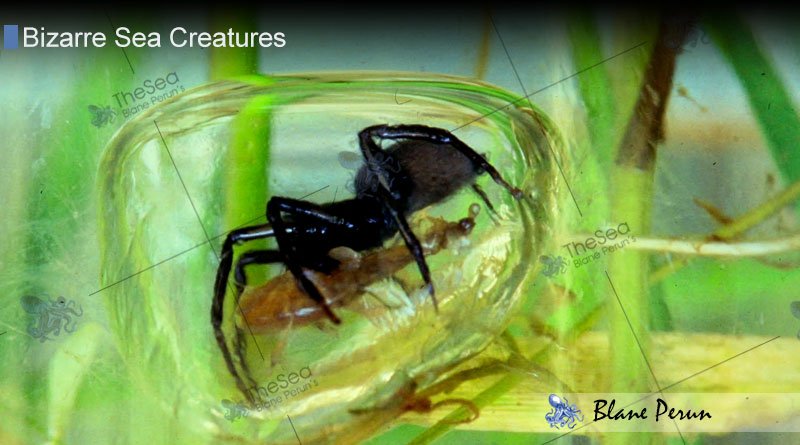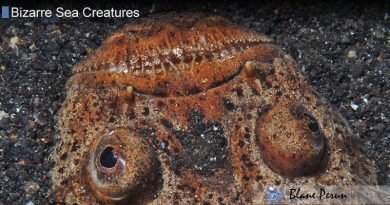Diving Bell Spider
The diving bell spider (Argyroneta aquatica) is the only known species of spider that spends almost all its life in water and is a genus of its own as well. The spider’s size ranges from 7.8 – 13.1 mm and it eats, catches its prey, mates and lays eggs in the water, coming to the surface only for breathing once a day.
The diving spider can be found in freshwater environments where aquatic vegetation is plentiful, such as lakes, ponds and marshes. The animal’s habitat ranges through almost all of mainland Europe, the northern part of the Asian continent. The species received its name from the shape of the webs built by these spiders to serve as a tool to capture prey as well as for mating and laying eggs (purposes served only by the webs built by females). The bells are built from a material made from waterproof silk that allow for gas exchange, but not the penetration of water into the spider home and a hydrogel that scientists have not yet determined. They are built between the submerged parts of aquatic plants and are filled with air bubbles that the dwellers take rising to the surface.
The diving spider’s bite is not dangerous for humans, but it is particularly painful. The small animal has very thin and sharp fangs that can pierce through human skin and leave behind a painful, swallowed bite mark. The animal’s bite can cause local inflammation and fever.
The Fascinating World of the Diving Bell Spider
When you think of spiders, your mind probably conjures up images of webs and insects trapped in sticky silk. But, let’s dive into the life of a unique arachnid, the Diving Bell Spider, scientifically known as Argyroneta aquatica. This remarkable creature defies the common perception that spiders belong exclusively on dry land. The Diving Bell Spider spends its entire life underwater, breathing air in a stunningly ingenious way. It’s a testament to the incredible adaptability and diversity of life on our planet. In addition to its remarkable adaptation to an aquatic life, the Diving Bell Spider showcases the fascinating variety of life forms that inhabit our environment, much like the goblin shark anatomy and features that intrigue marine biologists. Both creatures illustrate how evolution shapes distinct adaptations in response to their respective habitats, highlighting the beauty of biodiversity. As we explore such unique organisms, we gain a deeper appreciation for the intricate web of life on Earth.
Habitat and Adaptations
The Underwater Web
Unlike its terrestrial cousins, the Diving Bell Spider creates a web underwater, which serves as its home, hunting ground, and breathing apparatus. This spider spins a silk dome, anchored to aquatic plants, which it fills with air brought down from the surface. This bubble acts like a diving bell, hence the spider’s name. The spider’s ability to trap air in its web is a fascinating adaptation to its aquatic environment, allowing it to extract dissolved oxygen from the water, essentially “breathing” underwater.
Remarkable Respiratory Adaptations
The Diving Bell Spider’s unique respiratory system is a marvel of natural engineering. It has hydrophobic hairs on its abdomen and legs that trap air, forming a thin, silvery film around its body. This film functions as a physical gill, enabling gas exchange with the surrounding water. The spider periodically replenishes its air supply by darting to the surface, capturing a bubble of air, and bringing it back to its diving bell. This ingenious adaptation allows the spider to stay submerged for extended periods, making it a true aquatic arachnid. Additionally, the Diving Bell Spider’s ability to thrive underwater is paralleled by unique creatures in the frilled shark habitat and distribution. This adaptability not only showcases the diversity of life in aquatic environments but also highlights the intricate relationships between various species. Such adaptations are essential for survival in diverse ecosystems, further emphasizing the wonders of evolutionary biology.
Behavior and Diet
Hunting Strategies
The Diving Bell Spider is a skilled predator that has adapted its hunting techniques for an aquatic environment. It uses its web not only as a residence and oxygen supply but also as a trap for unsuspecting prey. Small invertebrates, such as water fleas and even small fish, can become entangled in the web. The spider then rushes out from its bell to immobilize its catch with venom before feasting at leisure within the safety of its air-filled dome.
Mating Rituals and Reproduction
The mating rituals of the Diving Bell Spider are as intriguing as its lifestyle. Males court females by plucking strands of their web, akin to a serenade. After a successful courtship, mating takes place within the female’s diving bell. The female lays her eggs in a silk cocoon attached to her bell, where she can guard them. The young spiders are born with the ability to survive underwater, quickly learning to build their own miniature diving bells.
Environmental Interactions
Predators and Prey Dynamics
The Diving Bell Spider plays a significant role in its aquatic ecosystem, both as a predator and prey. Its diet helps control the populations of aquatic invertebrates, contributing to the ecological balance. However, this spider is not without threats. It can fall prey to larger aquatic predators, such as fish and frogs. The delicate balance between the Diving Bell Spider and its environment highlights the intricate web of life in aquatic ecosystems.
Symbiotic Relationships
The Diving Bell Spider’s existence is closely tied to the health of its aquatic habitat. Its diving bell, while a marvel of biological engineering, also provides a microhabitat for small organisms. Some species of microorganisms may benefit from the oxygen-rich environment inside the bell, leading to a form of symbiosis. This interdependence underscores the importance of preserving aquatic habitats, not just for the spiders but for the myriad of life forms they support.
Conclusion
The Diving Bell Spider is a testament to the adaptability and ingenuity of life on Earth. Its unique lifestyle challenges our perceptions of where spiders can thrive and how they can solve the problem of living in an alien environment. From its remarkable respiratory adaptations to its underwater hunting strategies, the Diving Bell Spider offers a fascinating glimpse into the complexities of aquatic ecosystems and the incredible diversity of arachnid life.
FAQs on Diving Bell Spider
1. How does the Diving Bell Spider breathe underwater?
The Diving Bell Spider uses its web, filled with air from the surface, as a diving bell to extract dissolved oxygen from the water. It also has hydrophobic hairs that trap air around its body, allowing gas exchange directly with the water.
2. What does the Diving Bell Spider eat?
This spider preys on small aquatic invertebrates such as water fleas, and occasionally small fish, which it catches in its underwater web.
3. How does the Diving Bell Spider mate?
Males attract females by plucking at the strands of their web. Mating occurs within the female’s diving bell, where the eggs are later laid and guarded by the female.
4. Can Diving Bell Spiders live outside of water?
No, Diving Bell Spiders are uniquely adapted to an aquatic lifestyle and spend their entire lives underwater. They are not equipped to live outside of their aquatic habitat.
5. How do Diving Bell Spiders contribute to their ecosystem?
They help control populations of aquatic invertebrates, serving as a key predator in their ecosystem. Their diving bells also provide microhabitats for smaller organisms, highlighting their role in maintaining ecological balance in aquatic environments.




